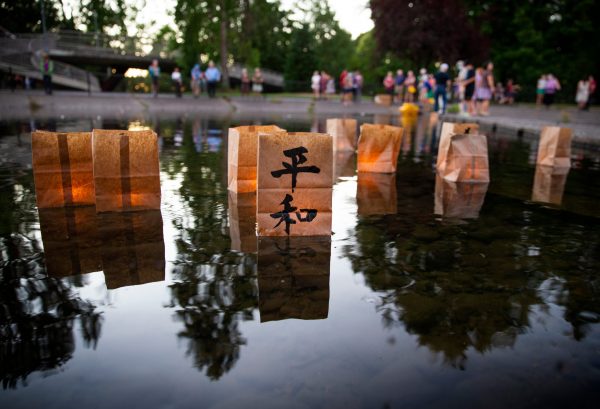Japan’s Nagasaki is an important example of a city engaged in global activism and activity. Despite its modest population of approximately 430,000, the city’s historical importance is unmistakable. As the only city during Japan’s Edo Period (1603–1868) that was open to the Western world, it possesses a unique cosmopolitan identity within the nation. Its local culture continues to boast a mix of Portuguese, Dutch, Chinese and other international influences.
As one of only two cities to suffer the tragedy of a nuclear bomb blast, Nagasaki, along with Hiroshima, also serves as a distinctive source of moral authority on nuclear abolition and non-proliferation.
Nagasaki is active in global advocacy for the abolition of nuclear weapons through the Mayors for Peace organisation, in which it serves as a vice president city. Nagasaki is active in city diplomacy on both the domestic and international fronts through its promotion of peace tourism, research on nuclear abolition, its sister-city relationships and activities that emphasise its history as an open city to the world.
Nagasaki’s impact is clearly visible in its role in the Mayors for Peace initiative. The origin of this organisation can be traced to 1982 during the second UN Special Session on Disarmament when Mayor Takeshi Araki of Hiroshima called on cities to come together to abolish nuclear weapons. At that same session, Mayor Hitoshi Motoshima of Nagasaki called for a total ban of nuclear weapons.
In 1991, after a series of conferences over the span of a decade that brought together cities from around the world, Mayors for Peace was registered as an NGO with special consultative status with the UN Economic and Social Council. The organisation now has over 8000 member cities from around the world. Each year on 9 August, the anniversary of the nuclear bomb explosion, the mayor of Nagasaki has a special platform from which to speak on the issues of nuclear abolition and non-proliferation.
As a city that seeks to use its unique experiences as a platform to advocate for change, we can see similarities to other cities in Japan which have become settings for international agreements and initiatives, such as Kitakyushu’s Initiative for a Clean Environment, Sendai’s Framework for Disaster Risk Reduction, and Minamata’s Convention on Mercury.
Beyond the Mayors for Peace organisation and the annual mayor’s speech, Nagasaki promotes research on nuclear weapons abolition through Nagasaki University’s Research Center for Nuclear Weapons Abolition. The NGO, Peace Boat, is also an important avenue for awareness on nuclear issues through its Hibakusha Project, which takes nuclear bomb survivors around the world to give testimony on their experiences.
Cruise ships also bring tourists to learn about Nagasaki’s role in Japan as the only open port during the Edo period and the tragic history of the nuclear bombing. Tourists also learn about the city’s unique Christian heritage and the role of historical figures such as Thomas Blake Glover, a Scottish merchant who helped usher in Japan’s modernisation during the Meiji era.
Nagasaki also plays a special role in the history of sister-city relations, which are now a common aspect of city diplomacy. Sister-cities flourished following the Second World War as a way to improve people-to-people relationships across country borders in order to make war less likely. The first sister-city link between the United States and Japan occurred between St Paul, Minnesota and Nagasaki on 7 December 1955, the anniversary of the attack on Pearl Harbour. Currently, Nagasaki has sister-city relationships with cities throughout the world such as Fuzhou, Leiden, Porto, Saint Paul, Santos and Vaux-sur-Aure.
Nagasaki demonstrates all the signs of active city diplomacy — global advocacy and a myriad of activities that help to maintain the city’s global identity. Cities should use their local history, experiences and resources to build networks and coalitions for action. As the world continues to deal with difficult problems like nuclear proliferation and climate change, we will continue to see cities network and collaborate to engage these issues.
As Japan continues to deal with the compounding problems of a stagnant economy and ageing population, we can also expect its cities — big, medium and small — to use both global resources to solve local problems and turn local experiences and expertise into shareable global resources.
Christophe Meyer is a lecturer at Nagasaki University of Foreign Studies.
Stephen Cullis is a special lecturer at Nagasaki University of Foreign Studies.
Daniel Clausen is a special lecturer at Nagasaki University of Foreign Studies.


Thanks for an informative article about many aspects of Nagasaki’s engagement with the world that I did not know about. More info about its sister city relationship St. Paul would be appreciated. Also, how would it try to engage with the domestic problems of economic stagnation and aging?
Thanks again.
Thank you for your comment. Richard. The link in the article to the St. Paul site will give you some background information. The free book by Sister Cities International “Peace Through People” also has a brief section on the relationship (about a page) – https://www.sistercities.org/about-us/our-mission/our-history/. Another article that deals extensively with the early years of Nagasaki and its sister city relationship with Saint Paul is here (this is significantly longer): https://apjjf.org/2015/13/32/Tomoe-Otsuki/4356.html This is a topic I hope to return to when I have more time to do research. As far as economic stagnation and aging, I will see if I can get one of my colleagues to answer that question. But in terms of solving problems in Japan, it is one thing to propose a solution and quite another to push this solution through many entangled layers of interests in business, politics, and the bureaucracy. Top-down problem solving is a ponderous affair.